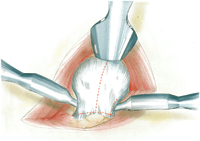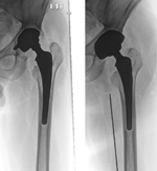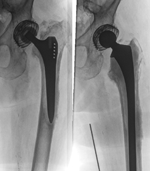Less invasive revision THA technique reduces complication rate, length of stay
COPENHAGEN, Denmark — German researchers have developed a less invasive revision total hip arthroplasty technique they claim can be applied in 30% to 50% of cases and yields lower complication rates and reduced length of hospital stay.
Torsten Prietzel, MD, presented the findings at the 12th EFORT Congress 2011, here.
The most important modification of the technique, Prietzel said, involves reconstructing the integrity of the capsule, with a long-term increase in joint stability — and decrease in dislocation risk — being achieved through the application of a larger ball-insert pair that depends upon the outer diameter of the socket.
“This less invasive surgical technique was developed 9 years ago and has already been used in more than 1,300 cases,” Prietzel, of Leipzig, Germany, said. “We are performing more and more revision total hip arthroplasty (THA) with this technique … By reducing the invasiveness of both primary and revision THA, we are able to achieve better functional outcomes, facilitate better rehabilitation and minimize risks — especially those associated with dislocation.”
|
|
|
|
This idealized illustration of the inverted T-shaped capsular incision with complete preservation of the acetabular origin shows an additional cranial incision made with a planned uncemented socket, which forms a U-flap (left). Capsular repair is performed by suture of both longitudinal incisions only, as suture of the semicircular incision near the base of the femoral neck is not necessary (right). Images: Prietzel T |
|
Difference in technique
The new technique, Prietzel said, is different from the conventional approach in that it applies larger hip balls and inserts following the expansion of the variety of available articulating joint components in 4-mm increments, and it involves sparing and reconstructing the joint capsule.
The point of sparing and reconstructing the joint capsule, according to Prietzel, is maintaining the integrity of its acetabular origin.
“The use of larger components provides much more stability and reduces the risk of dislocation,” he explained. “The reconstruction of the joint capsule partially restores the natural joint stability, which is normally continuously provided by atmospheric pressure … one side effect of capsular repair is that it supports the exact reconstruction of leg length because implantation under tension is no longer needed.”
|
|
|
For the data presented, the researchers combined their procedure with tissue dissection “strictly parallel to the direction of the muscle fibers.” From there, Prietzel said, the Bauer trans-gluteal approach was applied.
With an overall study period of 6.5 years, the team evaluated inpatient postoperative phases after THA and collected questionnaires completed by all patients in the cohort.
Study results
According to Prietzel, there were 55 cases in which the new, less invasive revision procedure was performed. There were no intraoperative method-specific complications — however, Prietzel reported one dislocation and one early infection. Mean postoperative stay for patients with the less invasive technique was 9.5 days, compared with the average of 20.5 days for all revisions.
The technique was primarily applied in isolated stem exchange followed by exchange of bearing components and complete joint exchange, but it could be difficult to apply the less invasive technique to isolated socket exchange with a stable stem, according to Prietzel.
“We have improved stability … and lowered complication rate,” he said. “Furthermore, there has been a considerable reduction of length of stay in the hospital. Thus, the modified methods are recommended both medically and economically.” – by Robert Press
Reference:
- Prietzel T, Farag M, Petermann M, et al. Less invasive revision total hip arthroplasty — A retrospective analysis after 55 operations. Paper #2282. Presented at the 12th EFORT Congress 2011. June 1-4. Copenhagen, Denmark.
- Torsten Prietzel, MD, can be reached at the Orthopaedic Department in the University of Leipzig, Liebigstraße 20, 04103 Leipzig, Germany; +49-341-9723273 or +49-341-9723160; email: torsten.prietzel@medizin.uni-leipzig.de.
- Disclosure: Prietzel has no relevant financial disclosures.





